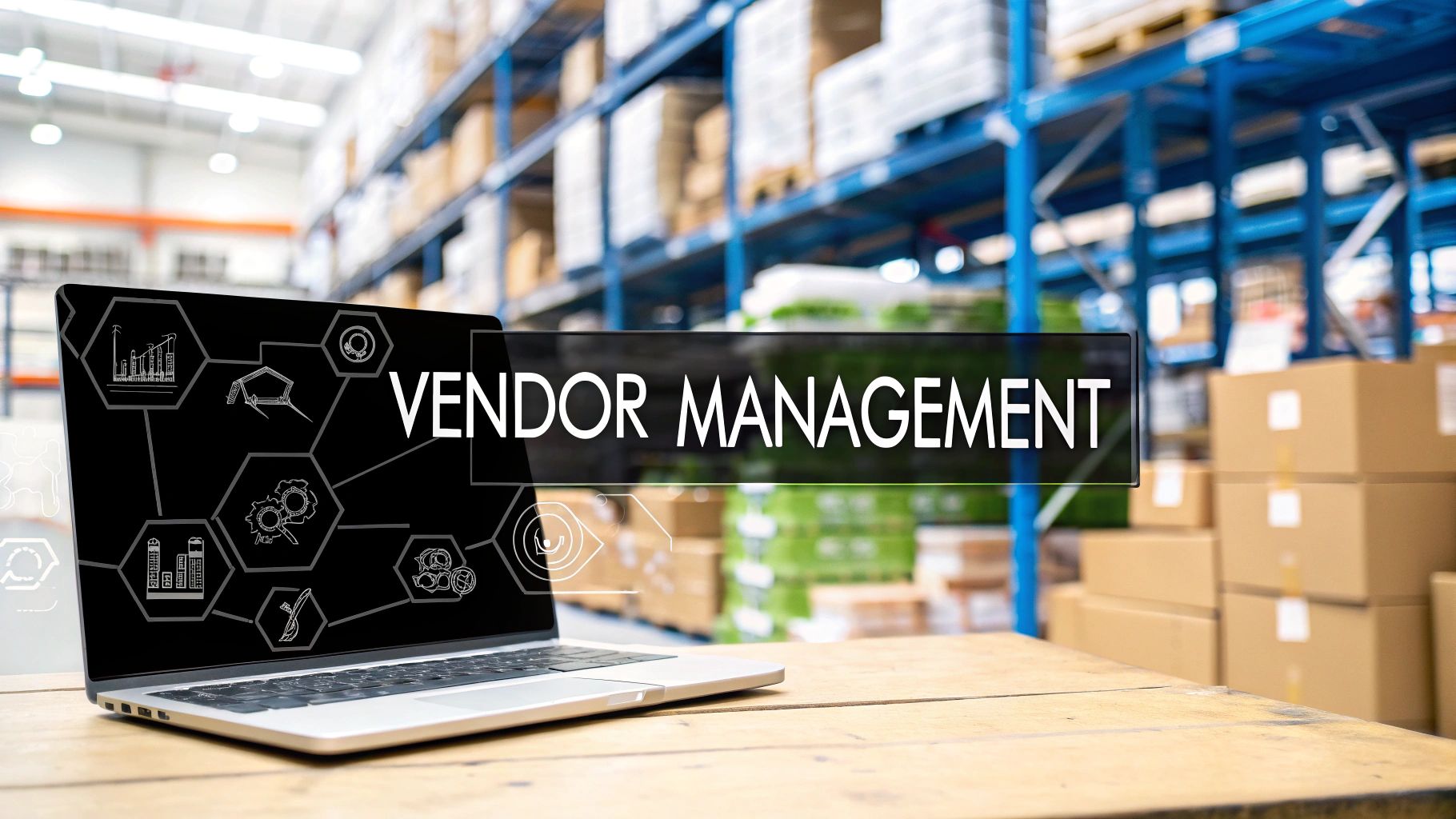Stay Updated with Everything about MDS
Thank you! Your submission has been received!
Oops! Something went wrong while submitting the form.

Chilat Doina
August 4, 2025
For high-growth e-commerce brands, managing suppliers isn't just an operational task; it's a critical competitive advantage. The difference between stagnant sales and exponential scaling often lies in how effectively you manage your network of partners, from manufacturers and 3PLs to software providers and marketing agencies. Sloppy vendor management leads to supply chain disruptions, quality control nightmares, and eroded profit margins. Conversely, mastering this discipline unlocks innovation, improves reliability, and builds a resilient foundation for growth.
This is especially true for the technology that powers your operations. Moving beyond transactional services, finding strategic IT partners who understand the e-commerce ecosystem can transform a simple vendor relationship into a true business asset. They become extensions of your team, proactively identifying opportunities and mitigating risks before they impact your customers. This strategic approach is a core element of effective vendor management.
This article moves beyond generic advice to provide a strategic framework tailored for the unique pressures of the e-commerce world. We will detail 8 actionable vendor management best practices that top sellers leverage to dominate their markets. You will learn how to implement structured processes for:
By implementing these best practices, you can prepare to transform your vendor relationships from a potential liability into your most powerful asset for scaling your brand.
Effective vendor management begins long before a contract is signed. The most successful e-commerce brands treat vendor selection not as a simple procurement task, but as a strategic partnership decision. This is where comprehensive due diligence and risk assessment become critical. It’s a systematic process of vetting potential suppliers to ensure they are stable, capable, and secure, preventing costly disruptions and brand damage down the line.

This foundational practice moves beyond just comparing price quotes. It involves a deep dive into a vendor's financial health, operational capacity, cybersecurity protocols, and compliance with industry regulations. For an e-commerce brand, this could mean verifying a 3PL’s warehouse security measures, a SaaS provider’s data privacy certifications (like SOC 2), or a manufacturer's ethical sourcing policies. For example, when initiating comprehensive vendor due diligence, it's crucial to understand the key factors to consider when selecting an outsourcing partner for specialized roles to ensure they align with your financial controls and growth trajectory.
To integrate this vendor management best practice into your operations, start by creating a tiered assessment system. Not all vendors carry the same level of risk.
Key Insight: Standardize your process by developing assessment templates and checklists for each tier. This ensures consistency and efficiency, allowing your team to make objective, data-driven decisions rather than relying on gut feelings. This structured approach is fundamental to building a resilient and scalable supply chain.
Once due diligence is complete, the next critical step in formalizing the vendor relationship is through robust contract management. A handshake agreement or a vague proposal is insufficient for a high-growth e-commerce brand. This practice involves creating detailed, legally sound contracts that explicitly define every aspect of the partnership. Central to these contracts are Service Level Agreements (SLAs), which translate expectations into measurable, enforceable performance metrics.
This structured approach transforms your vendor relationship from a casual arrangement into a strategic alliance with clear rules of engagement. It ensures both parties have a mutual understanding of all obligations, including deliverables, timelines, quality standards, and, crucially, the consequences for non-compliance. For example, a contract with a 3PL provider should have an SLA detailing order accuracy rates (e.g., 99.8%), fulfillment speed (e.g., 99% of orders shipped within 24 hours), and inventory shrinkage allowances. Similarly, tech giants like Amazon Web Services build their entire business model on detailed SLAs that guarantee specific uptime percentages and offer service credits if those commitments are not met.
To implement this vendor management best practice, you must move from general statements to specific, quantifiable terms. Avoid ambiguity at all costs.
Key Insight: A contract is not just a legal shield; it is a performance management tool. Use it actively. Your contract and its SLAs should be the foundation for your regular vendor performance reviews, providing objective data to guide conversations and drive continuous improvement.
A signed contract is not the end of the vendor management process; it's the beginning of an ongoing relationship that requires active oversight. Continuous performance monitoring is the systematic practice of tracking, measuring, and evaluating vendor performance against predefined Key Performance Indicators (KPIs) and Service Level Agreements (SLAs). This proactive approach ensures that partners consistently meet expectations, identifies potential issues before they escalate, and fosters a culture of accountability and continuous improvement.

For a high-growth e-commerce brand, this means moving beyond occasional check-ins to data-driven governance. Instead of simply assuming your 3PL is meeting its "ship within 24 hours" promise, you should be tracking order-to-ship times for every single order. This is a core component of effective vendor management best practices, transforming vendor relationships from a passive agreement into an active, optimized partnership. Industry leaders exemplify this: Procter & Gamble utilizes real-time supplier dashboards for complete supply chain visibility, while General Electric employs detailed supplier scorecards to evaluate quality, delivery, and cost, ensuring all partners align with their high operational standards.
To embed this practice, you must establish a formal, data-centric review framework. This ensures that evaluations are objective, consistent, and actionable.
Key Insight: Transparency is your most powerful tool. Share performance dashboards and scorecards directly with your vendors. When partners see the same data you do, it shifts the conversation from subjective complaints to collaborative, data-driven problem-solving, fostering a true partnership aimed at mutual success.
Not all vendors are created equal, and they shouldn't be managed as if they are. A one-size-fits-all approach to vendor relationships is inefficient and can leave your e-commerce brand vulnerable. Strategic vendor portfolio management is a sophisticated practice that involves classifying suppliers into distinct categories based on their business impact, spend, and risk level. This allows you to allocate your resources, time, and relationship-building efforts more effectively.
This systematic categorization helps you move from a reactive, transactional vendor relationship model to a proactive, strategic one. For a high-growth e-commerce business, this means identifying which vendors are true partners essential for innovation and growth versus those who are simply transactional suppliers. For instance, a bespoke packaging supplier that enables your unique unboxing experience is a strategic partner, while an office supply vendor is tactical. This approach is a cornerstone of modern vendor management best practices, ensuring focus is placed where it matters most.
The following infographic illustrates a common hierarchical model for vendor segmentation, breaking down the portfolio into strategic, preferred, and tactical tiers.

This hierarchy clarifies that management intensity should directly correlate with a vendor's impact and spend, allowing for more efficient resource allocation across your entire supplier base.
To implement this practice, you must first define clear, objective criteria for each vendor category. This prevents arbitrary classifications and ensures alignment across your organization.
Key Insight: Regularly reassess and recategorize your vendors at least annually or when significant business changes occur. A tactical supplier could evolve into a strategic partner as your business scales and its needs change. This dynamic approach ensures your vendor management strategy remains aligned with your overarching business objectives.
Once a vendor is onboarded, the nature of your interaction shifts from evaluation to collaboration. Treating vendor relationships as purely transactional is a common pitfall that limits growth and innovation. Instead, one of the most crucial vendor management best practices involves fostering strong partnerships through structured communication and deliberate relationship management. This transforms a simple supplier arrangement into a strategic alliance focused on mutual success and long-term value creation.

This approach goes beyond just sending purchase orders and processing invoices. It involves establishing clear communication channels, regular performance reviews, and joint planning sessions. Think of Apple's deep integration with its key suppliers like Foxconn, where collaboration is essential for rapid product development and iteration. Similarly, an e-commerce brand can work closely with its 3PL provider to co-develop more efficient packaging or streamline return processes, creating wins for both parties. For a deeper dive, exploring the core tenets of vendor relationship management best practices can provide a framework for building these powerful, collaborative partnerships.
To build a culture of collaboration, you must be intentional about how you structure and manage vendor interactions. A systematic approach ensures that communication is productive and goal-oriented.
Key Insight: The foundation of strong vendor relationships is transparency and trust. Document key decisions, discussions, and action items in a shared space or through meeting summaries. This practice creates accountability and a clear historical record, preventing misunderstandings and ensuring both teams are aligned on expectations and next steps.
In today's interconnected e-commerce landscape, your brand's security is only as strong as its weakest link, which is often a third-party vendor. Implementing robust information security and data protection is a non-negotiable vendor management best practice. It involves establishing a comprehensive framework of security protocols, assessments, and controls to safeguard your sensitive data, customer information, and intellectual property when accessed or handled by external partners.
This practice extends far beyond simple password policies. It’s a proactive strategy to ensure vendor activities do not introduce vulnerabilities into your ecosystem. For a growing e-commerce brand, this means demanding proof of security from your SaaS platforms, marketing automation tools, and fulfillment partners. For instance, major financial institutions enforce stringent data security addendums with all fintech vendors, while healthcare organizations mandate strict HIPAA compliance for any partner handling patient information. Similarly, global enterprises like Microsoft require critical cloud service providers to maintain SOC 2 compliance, setting a clear standard for vendor security assurance.
To weave robust security into your vendor relationships, you must integrate security checkpoints throughout the vendor lifecycle, from selection to offboarding.
Key Insight: Treat vendor security as an extension of your own. Standardize your security requirements in a formal policy or addendum that is included in every vendor contract. This document should clearly define data ownership, protection responsibilities, breach notification timelines, and audit rights, creating a legally binding foundation for secure collaboration.
Navigating the complex web of laws, regulations, and industry standards is a non-negotiable aspect of modern e-commerce. A systematic approach to compliance ensures that every vendor relationship, from your payment processor to your overseas manufacturer, adheres to all applicable rules. This practice involves continuous monitoring, formal audit procedures, and rigorous documentation to mitigate legal risks, avoid hefty fines, and protect your brand’s reputation.
For a growing e-commerce brand, this means ensuring your fintech partners are compliant with financial regulations like anti-money laundering (AML) laws, or that your third-party logistics (3PL) provider meets all safety and labor standards. Ignoring this crucial area of vendor management best practices can lead to operational shutdowns, legal battles, and a complete loss of customer trust. For example, a brand selling health supplements must ensure its manufacturing vendors strictly adhere to FDA regulations to avoid product recalls and legal liability.
To embed robust compliance management into your vendor lifecycle, you need a proactive and organized system rather than a reactive one. Start by building a centralized repository of all relevant compliance requirements.
Key Insight: Treat compliance not as a one-time check at onboarding, but as a continuous, dynamic process. Regulations change, and your vendors' operations evolve. Implementing a regular audit and review cadence is essential to maintaining adherence over the entire lifetime of the partnership and safeguarding your business.
A mature vendor management strategy acknowledges that relationships are not permanent. Whether due to underperformance, a strategic pivot, or the end of a contract term, partnerships conclude. Strategic exit planning and business continuity is the practice of proactively preparing for these transitions to ensure your e-commerce operations continue seamlessly, safeguarding revenue and customer satisfaction. It involves creating a detailed playbook for offboarding a vendor and, if necessary, activating a backup plan.
This forward-thinking approach prevents the frantic scrambling that often accompanies an unexpected vendor failure or contract termination. For an e-commerce brand, this could mean having an alternative shipping carrier vetted and ready, or a documented process for migrating customer data from one CRM to another. A manufacturer might have a secondary supplier for a critical component, while a large Amazon seller might explore different business models to de-risk their operations, a concept that is crucial when considering how to plan an exit strategy for your Amazon business to maximize value. The goal is to make a vendor transition a controlled, predictable event, not a business-threatening crisis.
Integrating this into your vendor management best practices requires thinking about the end at the beginning. Build exit considerations directly into your vendor lifecycle management.
Key Insight: Treat vendor exit plans with the same seriousness as your onboarding process. By documenting and formalizing exit strategies during the negotiation phase, you retain control and ensure business continuity, transforming a potential vulnerability into a manageable, planned operational procedure.
Navigating the complexities of a high-growth e-commerce brand requires more than just a great product and clever marketing. It demands a robust, resilient, and agile operational backbone. As we've explored throughout this guide, that backbone is forged through a disciplined approach to vendor management. Adopting these vendor management best practices is not about adding restrictive bureaucracy; it’s about architecting a strategic advantage.
The journey from a promising startup to a dominant e-commerce player is paved with strategic partnerships. Each vendor, from your 3PL provider to your digital marketing agency, is a critical cog in your business machine. The principles we've detailed are not isolated tasks to be checked off a list. They are interconnected components of a holistic strategy designed to fortify your brand against an unpredictable market.
Let's distill the essential takeaways from the practices we've covered. Think of these not as separate steps, but as a continuous, cyclical process that evolves with your business:
Mastering these concepts is a marathon, not a sprint. The key is to start now, with intention and focus. Here are your immediate next steps:
Ultimately, superior vendor management is about building a powerful, external team that is just as invested in your success as your internal one. It's about creating a network that provides not just services, but also stability, innovation, and a competitive edge. By treating your vendor network with the strategic importance it deserves, you are not just managing costs or services. You are building a sustainable, scalable, and ultimately more valuable e-commerce enterprise.
Ready to learn how the world's top e-commerce entrepreneurs implement these vendor management strategies and more? Join Million Dollar Sellers, an exclusive community where 7-, 8-, and 9-figure founders share the exact playbooks they use to source, manage, and scale their vendor partnerships for maximum growth. Surround yourself with the best in the business and gain access to proven strategies you won't find anywhere else.
Join the Ecom Entrepreneur Community for Vetted 7-9 Figure Ecommerce Founders
Learn MoreYou may also like:
Learn more about our special events!
Check Events